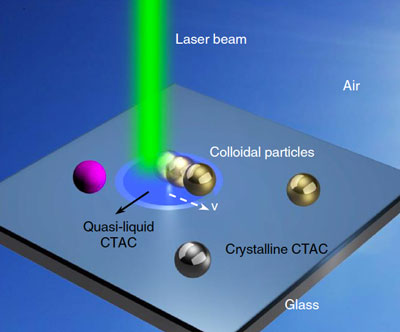| Dec 13, 2019 | |
The first optical nanomanipulator on solid substrates |
|
| (Nanowerk Spotlight) Colloidal particles are promising building blocks to construct functional nanostructures, materials and devices. Researchers have developed numerous optical techniques, including optical tweezers (see for instance: "Manipulating colloids with mobile nanotweezers") to trap, manipulate, and assemble colloidal particles in fluidic environments at single-particle resolution. | |
| "When these techniques are operated in liquid environments, they generally suffer from pattern collapses, Brownian motion, and challenges that come with reconfigurable assembly," Jingang Li, a graduate student in Prof. Yuebing Zheng's research group at The University of Texas at Austin, explains to Nanowerk. "This has motivated us to develop an optical technique for the versatile manipulation and dynamic patterning of colloidal particles with a wide range of materials, sizes, and shapes on solid substrates at nanoscale accuracy." | |
| The group has now demonstrated the first optical nanomanipulator on solid substrates. | |
| Generally, due to the van der Waals friction that occurs at solid-solid interfaces (read more about friction at the nanoscale), manipulating nanoparticles on solid substrates is much more difficult than in fluids. | |
| One option is to physically manipulate nanoparticles with the tip of an atomic force microscope (AFM). But this technique often causes undesired tip and particle deformation as well as particle adhesion to the tip. | |
| In contrast, Zheng's team shows that by introducing a surfactant layer to modify the particle-substrate interactions, a variety of colloidal particles can be manipulated in a non-invasive and contactless way through coordinating optical heating and scattering forces. | |
 |
|
| Schematic illustration of the general concept of optothermally-gated photon nudging on a solid substrate. (Reprinted with permission by Nature Publishing Group) | |
| This novel technique, reported in Nature Communications ("Optical nanomanipulation on solid substrates via optothermally-gated photon nudging"), provides a versatile and powerful platform to manipulate and reconfigurably assemble colloidal particles on solid substrates, without the need to involve fluidic environments. | |
| "We termed our technique optothermally-gated photon nudging (OPN)," says Li, who is the paper's first author. "A thin surfactant layer is introduced between the particles and the glass substrate, acting as an optothermal gate to modify particle-substrate interfacial interactions. With the optical heating of the particles, the friction of the particle and surfactant is dramatically reduced due to the phase transition of the surfactant layer, allowing the manipulation of particles with optical scattering forces." | |
| Optical manipulation of a variety of colloidal particles of different materials and sizes. (Video Zheng research group at UT Austin) | |
| This technique represents a milestone in pushing the working conditions of optical tweezers from fluidic to solid phases, which is capable of versatile manipulation and dynamic assembly of colloidal nanostructures on solid substrates directly. | |
| Having demonstrated optical manipulation on a solid substrate, the team's next steps are 1) extending this technique to more general materials, such as silicon nanowires; 2) applying this technique for dynamic assembly of colloidal nanostructures for fundamental studies and practical applications, such as chiroptical metamaterials; and 3) integrating a spatial light modulation and feedback control to further boost the efficiency of this technique. | |
| "We can think of several efforts to further enhance the strengths of OPN," Zheng points out. "One is optimizing the optics. For instance, oblique incidence of the laser can take advantage of photon momentum along the direction of beam propagation, which could enhance both amplitude and directional control of the driving forces." | |
| "While OPN offers the opportunity to manipulate colloids at single-particle resolution, it suffers from relatively low patterning throughput, which is primarily limited by its serial and manual control," he adds. "The implementation of a light spatial modulator with a digital feedback control will open up the possibilities for automatic and parallel manipulation to significantly boost the production output." | |
 By
Michael
Berger
– Michael is author of three books by the Royal Society of Chemistry:
Nano-Society: Pushing the Boundaries of Technology,
Nanotechnology: The Future is Tiny, and
Nanoengineering: The Skills and Tools Making Technology Invisible
Copyright ©
Nanowerk LLC
By
Michael
Berger
– Michael is author of three books by the Royal Society of Chemistry:
Nano-Society: Pushing the Boundaries of Technology,
Nanotechnology: The Future is Tiny, and
Nanoengineering: The Skills and Tools Making Technology Invisible
Copyright ©
Nanowerk LLC
|
|
|
Become a Spotlight guest author! Join our large and growing group of guest contributors. Have you just published a scientific paper or have other exciting developments to share with the nanotechnology community? Here is how to publish on nanowerk.com. |
|
